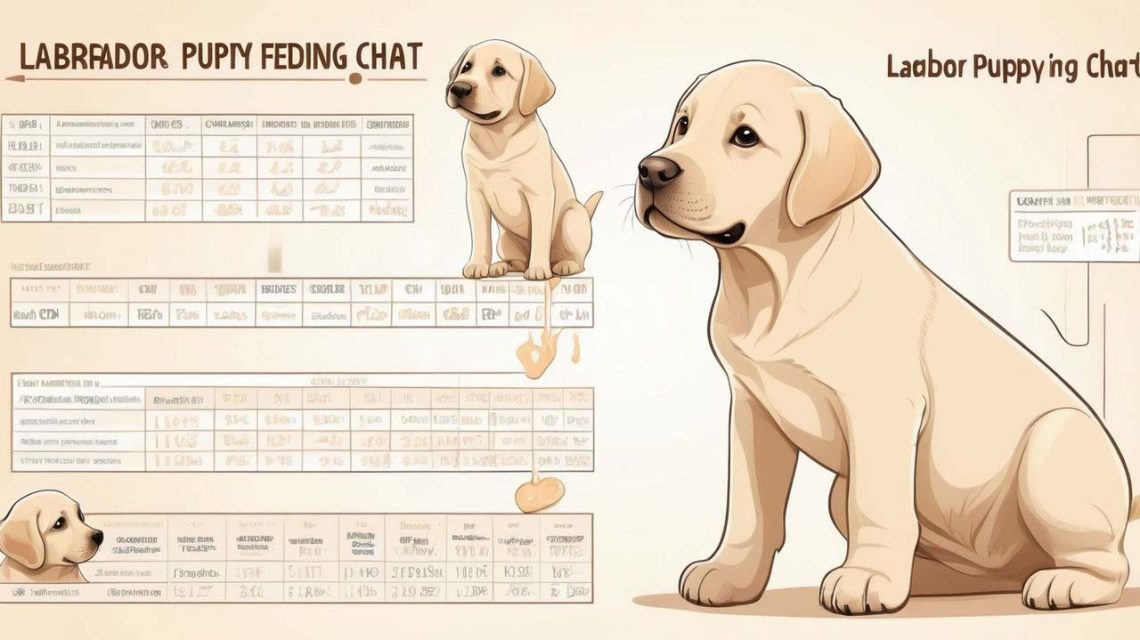Feeding a Labrador puppy properly sets the stage for a healthy, happy dog. With the right portions, feeding schedule, and a carefully balanced diet, Labrador puppies can reach their full potential. This Labrador puppy feeding chart will guide you through every growth stage, ensuring your Labrador gets the ideal nutrition for their development.
Understanding the Labrador Puppy Feeding Chart
Why a Feeding Chart is Crucial for Labrador Puppies
Labradors are known for their energy, intelligence, and love for food! However, without a structured feeding chart, it’s easy to accidentally overfeed or underfeed your Labrador puppy. The Labrador puppy feeding chart provides clear guidelines to support balanced growth, strong muscles, and a healthy weight.
Nutritional Needs Unique to Labrador Puppies
Labrador puppies require a diet high in protein, fats, and specific minerals, such as calcium and phosphorus, which aid in bone and muscle growth. Since Labradors grow quickly, their diet needs to support healthy development to avoid joint and skeletal issues later.
Age-Based Labrador Puppy Feeding Chart
8–12 Weeks: Establishing Early Eating Habits
During this period, Labrador puppies are growing rapidly. Following a Labrador puppy feeding chart helps structure their meals, introducing small, frequent feedings throughout the day. At this stage, they need about four small meals daily, containing nutrient-dense food to support fast growth.
3–6 Months: Adjusting Portion Sizes
Between three and six months, you may notice your Labrador’s appetite increasing. This stage is ideal for gradually increasing portion sizes, while still feeding three meals per day. Paying attention to your puppy’s weight and activity level is essential to adjusting the feeding amounts.
6–12 Months: Transitioning to Fewer Feedings
As your Labrador puppy nears one year, you can reduce feedings to twice daily. Gradually lowering the amount of food in each meal while adjusting for their changing energy levels helps them transition comfortably.
1 Year and Beyond: Moving to Adult Dog Food
Once your Labrador reaches about a year, they’re ready for adult dog food. Transition them gradually by mixing in adult food with puppy food, following a feeding chart to determine appropriate adult portions.

Ideal Portion Sizes in a Labrador Puppy Feeding Chart
Calculating Portion Sizes by Weight
Portion sizes in a Labrador puppy feeding chart are typically based on weight. Consult the feeding guide on puppy food packaging, as it provides recommended amounts per pound. Regular vet check-ups can also help you adjust portion sizes.
Common Signs of Underfeeding or Overfeeding
Underfed puppies may show signs of lethargy or look too thin, while overfed puppies often gain weight quickly, becoming chubby. Monitoring your Labrador’s body shape, energy, and regular weight is key in adjusting portion sizes.
Feeding Frequency Recommendations by Age
How Often to Feed Labrador Puppies by Growth Stage
Labrador puppies require different feeding frequencies based on their age. Generally, puppies up to three months need four meals per day, those between three to six months need three meals, and from six months onward, two meals daily are sufficient.
Balancing Feeding Frequency as Labradors Mature
As your Labrador puppy grows, balancing their diet to match their energy levels is essential. You might find that they need slightly more or less than the feeding chart suggests, depending on their physical activity and health.
Nutritional Components in a Labrador Puppy Diet
Protein Needs for Muscle Development
Protein is the foundation of a Labrador’s growth. High-quality proteins, such as chicken, beef, or fish, help your puppy develop lean muscle, keeping them active and healthy.
Fats and Essential Fatty Acids
Healthy fats are essential for energy and brain development. Labradors, known for their intelligence, benefit from fatty acids like omega-3s and omega-6s found in fish oils and high-quality puppy food.
Calcium and Phosphorus for Bone Health
Calcium and phosphorus help your Labrador’s bones grow strong. Since Labradors are prone to joint issues, a balanced amount of these minerals is vital in their diet, promoting sturdy bones and healthy joint development.
Creating a Balanced Feeding Schedule for Your Labrador Puppy
Sample Daily Feeding Schedule for Labrador Puppies
A sample feeding schedule for a Labrador puppy might include meals at 7 a.m., 12 p.m., 5 p.m., and 9 p.m. for puppies under three months, with adjustments made as they grow.
Keeping Consistency in Feeding Times
Consistency in feeding times helps puppies establish a routine, reducing anxiety and promoting better digestion. A structured schedule also allows you to monitor your puppy’s feeding habits and make necessary adjustments.
Monitoring Growth and Adjusting the Labrador Puppy Feeding Chart
Weighing Your Labrador Puppy Regularly
Regular weigh-ins help you track your Labrador puppy’s growth and adjust feeding portions as necessary. Puppies should ideally be weighed every two to three weeks, especially in their first six months.
When to Adjust Portions Based on Growth
If your puppy appears too thin or chubby, it’s time to adjust portions. A balanced Labrador puppy feeding chart ensures your puppy receives just the right amount of food based on their body’s needs.
Transitioning Labrador Puppies to New Food
Signs Your Puppy is Ready for New Food
Signs that your Labrador puppy is ready for new food include slowed growth, increased energy, and the one-year mark approaching. Your vet can also help determine when it’s time to make the switch.
Step-by-Step Food Transition Guide
To transition, start by mixing 25% new food with 75% current food for a few days, then gradually increase the new food proportion until it’s a complete switch. This method prevents digestive upset.
Avoiding Common Feeding Mistakes with Labradors
Overfeeding and Risks of Obesity
Labradors love food, but overfeeding can lead to obesity and associated health problems. Stick to your Labrador puppy feeding chart to ensure balanced portions and prevent excessive weight gain.
Avoiding Harmful Human Foods
Certain foods like chocolate, grapes, and onions are dangerous for Labradors. Always provide food specifically formulated for puppies, and avoid table scraps.
Frequently Asked Questions About Labrador Puppy Feeding
How much should I feed my Labrador puppy per day?
- Follow the Labrador puppy feeding chart based on their weight, adjusting as they grow and become more active.
Can I feed my Labrador puppy treats?
- Yes, but treats should be limited to 10% of their daily calorie intake to avoid weight issues and maintain balanced nutrition.
When can I switch my Labrador puppy to adult food?
- Typically, Labradors transition to adult food around 12 months, but consult your vet to determine the best time based on your puppy’s growth.


